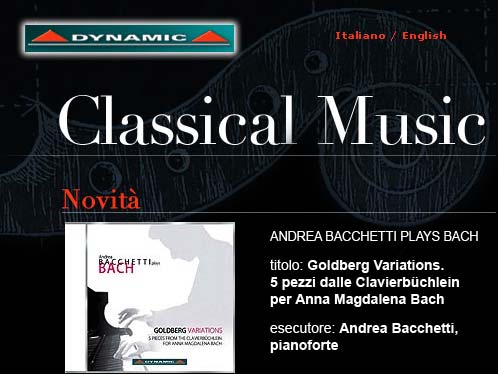
INFORMATION:
Bach's Goldberg Variations, in fact, represent one of the most brilliant examples of the far-reaching
overturning of the most traditional canons of the varied theme as conceived by instrumental virtuosi
in the eighteenth and nineteenth centuries and the advent of a wholly new concept of the genre.
As Alberto Basso so rightly wrote in his Frau Musika, in the case of Bach «the prodigious
attention to musical construction and the immaculate impulse to range through all the grades of
speculation into the system of sounds and their organisation in geometrical and symbolic concatenations
which had so filled Bach's mind in the previous ten years drove him to seek the solution to this
question and led him to set up a new principal of construction which tore up and dispersed the system
that had been adopted previously.»
The Goldberg Variations BWV 988 are one of the highest moments of this particular approach by Bach,
where the composer's esprit de géometrie is blended with a conception of the variation that goes well
beyond the limits of the typically ornamental model in which it was generally understood at the time.
Bach wrote two sets of harpsichord pieces, both entitled Clavierbüchlein, the first in 1772 and the
second three years later in 1725, for his second wife Anna Magdalena. Alongside various single pieces
that were not used again, the collections contain the first drafts of works that were later to become
parts of other important collections, like the French Suites and the Well-tempered Clavier.
This is seen, for example, in the Praeludium in C major (track 37) which will be found identical at
the start of the first volume of the Well-tempered Clavier; in the Aria in G major (track 36), which,
with some variants, will be the starting point for the Goldberg Variations; and again in the chorale
Wer nun den lieben Gott (track 34), which will be found again in a later manuscript collection of chorales.
Other pieces are works by various composers: in some cases they are composition exercises of Bach's
children - like the Marche in G major Anh 122 (track 35), which may be attributed to his son Carl
Philipp Emanuel - whereas others are simple transcriptions, like the Menuet in G major Anh 114 (track 33),
which in reality was written by Johann Christoph Petzold.
Track List:
Goldberg Variations:
- Aria 03:19
- Variation 1 01:48
- Variation 2 01:24
- Variation 3 (Canone all'unisono) 01:56
- Variation 4 01:03
- Variation 5 01:37
- Variation 6 (Canone alla Seconda) 01:19
- Variation 7 (al tempo di Giga) 01:44
- Variation 8 01:46
- Variation 9 (Canone alla Terza) 01:24
- Variation 10 (Fughetta) 01:36
- Variation 11 02:03
- Variation 12 02:02
- Variation 13 03:35
- Variation 14 02:01
- Variation 15 (Canone alla Quinta, Andante) 02:42
- Variation 16 (Ouverture) 02:43
- Variation 17 01:57
- Variation 18 (Canone alla sesta) 01:24
- Variation 19 01:09
- Variation 20 01:50
- Variation 21 (Canone alla settima) 02:00
- Variation 22 (Alla breve) 01:22
- Variation 23 02:03
- Variation 24 (Canone all'Ottava) 02:30
- Variation 25 05:13
- Variation 26 02:03
- Variation 27 (Canone alla Nona) 01:37
- Variation 28 02:20
- Variation 29 01:58
- Variation 30 (Quodlibet) 01:28
- Aria da Capo 02:05
Nach Klavierbüchlein für Anna Magdalena Bach:
- Menuet G-Dur von Chr. Petzold BWV Anh. 114
(Canone alla Nona) 00:58
- Choral "Wer nun den lieben Gott laesst walten"
von J.S. Bach BWV 691 01:18
- Marche G-Dur von Ph.E. Bach BWV Anh. 122 00:40
- Aria fuer Klavier G-Dur von J.S. Bach 988,1 (Quodlibet) 02:00
- Praeludium C-Dur von J.S. Bach, BWV 846,1 02:29
TOTAL RUNNING TIME 72:51